The Enterprise Rights Management Solution Market is estimated to be valued at USD 7.2 billion in 2025 and is projected to reach USD 40.9 billion by 2035, registering a compound annual growth rate (CAGR) of 18.9% over the forecast period.
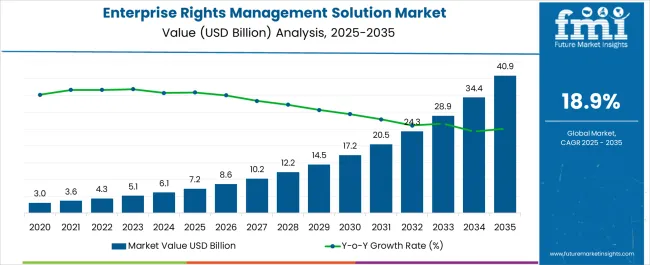
| Metric | Value |
|---|---|
| Enterprise Rights Management Solution Market Estimated Value in (2025 E) | USD 7.2 billion |
| Enterprise Rights Management Solution Market Forecast Value in (2035 F) | USD 40.9 billion |
| Forecast CAGR (2025 to 2035) | 18.9% |
The enterprise rights management (ERM) solution market is expanding as organizations increasingly prioritize data protection, regulatory compliance, and secure collaboration across digital ecosystems. Rising cyber threats, coupled with stricter global data privacy regulations, have accelerated the adoption of ERM solutions to safeguard sensitive corporate information both within and beyond organizational boundaries. Investor briefings and technology updates have highlighted strong enterprise spending on data security platforms that combine encryption, access control, and policy enforcement.
Advancements in integrated solutions, particularly those combining ERM with data loss prevention and identity management systems, are broadening application scope. Cloud adoption has further enabled scalability and flexibility, supporting enterprises with distributed workforces and remote operations.
Looking ahead, growth is expected to be shaped by large enterprise investments in comprehensive data protection frameworks, the rise of cloud-native security models, and continuous innovation in AI-driven monitoring and adaptive access technologies, ensuring that ERM solutions remain central to enterprise cybersecurity strategies.
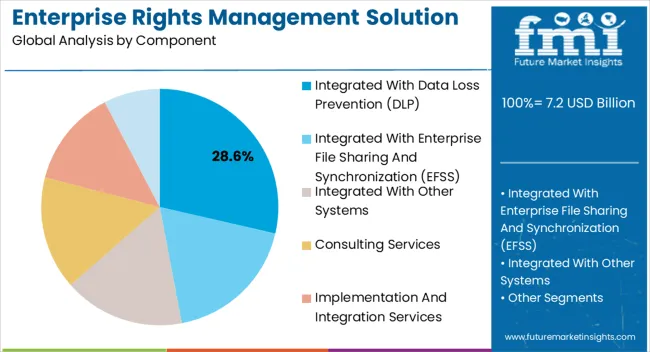
The integrated with DLP segment is projected to account for 28.6% of the enterprise rights management solution market revenue in 2025, reflecting growing demand for unified data security frameworks. Integration with DLP has been driven by the need to provide real-time monitoring, contextual analysis, and policy enforcement that go beyond traditional rights management.
Organizations have favored combined ERM and DLP solutions to achieve greater visibility into data movement, reduce the risk of insider threats, and maintain compliance with international data governance standards. Technology reports have emphasized that such integrations enable businesses to prevent sensitive data leakage while maintaining seamless collaboration.
As enterprises increasingly adopt hybrid and multi-cloud environments, the need for integrated solutions capable of securing data across diverse platforms has grown, sustaining the segment’s relevance and growth trajectory.
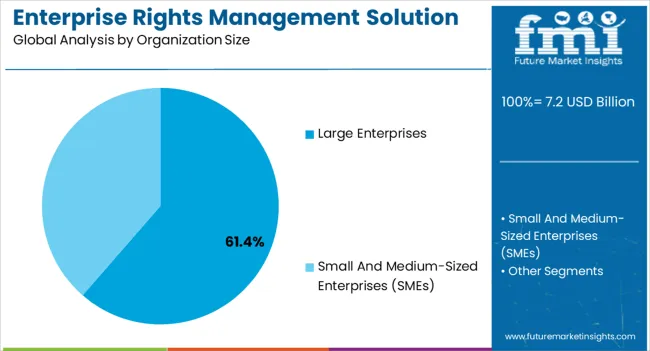
The large enterprises segment is projected to capture 61.4% of the enterprise rights management solution market revenue in 2025, maintaining its dominance due to complex data environments and higher compliance responsibilities. Large organizations manage vast volumes of sensitive data across global operations, requiring advanced rights management to prevent unauthorized access and intellectual property theft.
Annual reports from cybersecurity vendors have indicated that large enterprises allocate significant budgets to integrated security platforms, with ERM forming a critical component of enterprise-wide data protection strategies. Regulatory pressures in industries such as finance, healthcare, and technology have further accelerated adoption, as these enterprises face strict requirements for data confidentiality and reporting.
The scale of digital transformation initiatives, including cloud migration and remote workforce enablement, has also increased reliance on ERM solutions. As data protection continues to be a strategic priority, large enterprises are expected to remain the primary drivers of ERM market demand.
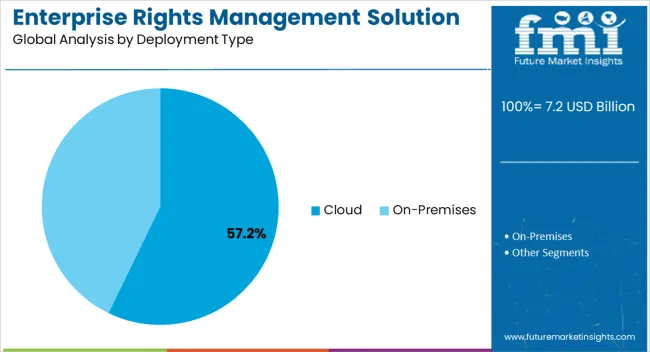
The cloud segment is projected to hold 57.2% of the enterprise rights management solution market revenue in 2025, underscoring the growing preference for flexible, scalable, and cost-efficient security deployments. Cloud-based ERM solutions have gained traction due to their ability to provide centralized policy enforcement, rapid updates, and simplified integration with other cloud applications.
Organizations have adopted cloud deployment to support remote workforces and global teams, ensuring secure collaboration without relying on traditional on-premises infrastructure. Press releases and analyst presentations have highlighted that cloud-native ERM offerings enable faster deployment cycles and better alignment with evolving cybersecurity frameworks.
Moreover, cloud deployment reduces capital expenditure while providing elastic scalability to match fluctuating enterprise workloads. The segment has also benefited from advancements in zero-trust security models and AI-driven cloud monitoring, enhancing resilience against emerging cyber risks. With enterprises continuing to prioritize digital transformation, the cloud segment is expected to strengthen its leadership in ERM solution deployment.
Various businesses throughout the world are focused on quickly establishing their position on multiple social media platforms and other online marketing channels. Companies may employ a content marketing plan to promote their ability, earn cash digitally and enhance revenue. This resulted in the establishment of intellectual property rights, as well as a surge in demand for enterprise rights management solutions and licensing.
Furthermore, increased use of enterprise rights management solution technologies by organizations that employ electronic files such as PDFs, Word documents, and emails is driving the global market growth. Content owners are obligated to restrict data from being transmitted from one platform to the next without authorization, which, in turn, acts as a driving factor for the enterprise rights management business.
Pharmaceutical companies and banking and finance corporations utilize enterprise rights management solutions to guarantee adherence to data security and confidentiality regulations. As a result, the surge in safety concerns is projected to create opportunities for the enterprise rights management solution industry to flourish.
The entry of enterprises into digital channels in order to increase their presence is increasing cases of web-based data fraud. While developing information on the web, consumers and buyers are particularly vulnerable to hacks.
This increases the demand for efficient enterprise rights management systems. Bringing your own device (BYOD) is becoming more popular in many organizations, creating a new avenue for service suppliers. Approximately 59% of enterprises have used BYOD in their workplaces.
According to the survey, IT businesses account for 36% of the turnover in the enterprise rights management solution market. Moving forward, increased occurrences of cybercrime are driving businesses to use enterprise rights management systems.
According to Infosecurity, worldwide computer crime has increased by 56%. Increasing workplace mobility raises serious concerns regarding security protocols. As a result, ERMSs are now a must for corporations. According to the report, around 43% of firms have chosen enterprise mobility.
Expensive enterprise rights management technologies and administrative expenses are major constraints. Low-cost ERM solutions may not be successful in offering robust content protection against inappropriate access.
Moreover, the high price of enterprise rights management solutions is expected to hamper industry growth. Most items in the industry have a monthly price scheme. Other low-cost market solutions, like watermarking and password protection, can serve as a replacement for enterprise rights management systems.
As a result, the high price of ERM technologies may limit the enterprise rights management solution industry.
Progress in Over-The-Top (OTT) demand and consumption is expected to provide the industry with remunerative opportunities in the coming years. The concept of OTT media distribution has emerged as the most widespread in the current entertainment business.
With over 500 hours of content posted per minute and more than 250 million monthly visits, YouTube has become a vital avenue for the creative industry to engage and maintain productivity. In addition, premium OTT media providers enable their users to see big-budget, ERM-protected material from the convenience of their own residences.
This promotes the growth of online streaming, allowing different enterprise rights management strategies to safeguard and commercialize their content, contributing to the creation and growth of the enterprise rights management solution business.
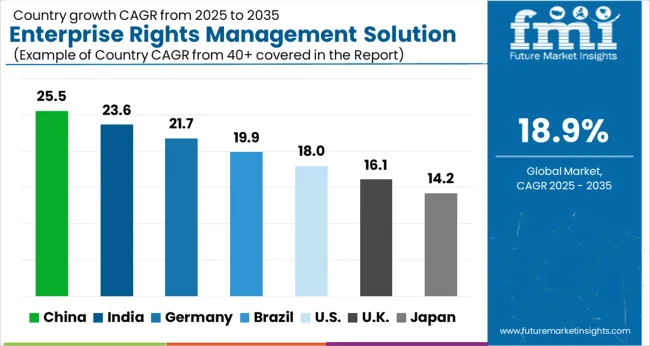
Asia Pacific (APAC) is expected to be the most profitable area in the enterprise rights management solution market. In India, the government's attempts, like currency devaluation and advancements, are driving businesses to place a greater emphasis on online data security. The financial industries are driving the APAC enterprise rights management solution market.
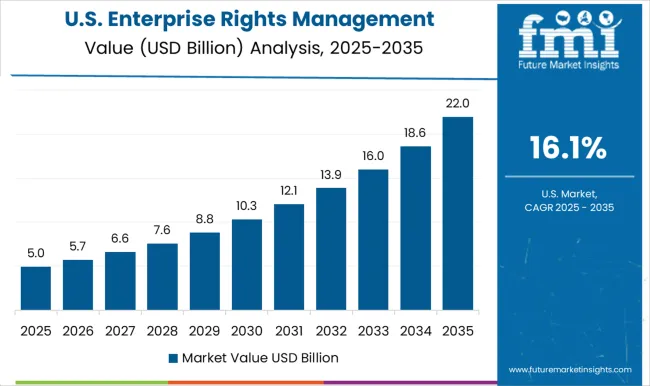
The North American market accounted for the largest adoption rates in the worldwide enterprise rights management solution industry. North America presently dominates the market, accounting for 38.4% of the total throughout the projected period, due to the existence of prominent service suppliers, such as Microsoft, Oracle, and Seclore. A plethora of technological breakthroughs has been tested in the United States. Moreover, governments in North America are enforcing severe data security protocols on businesses of all sizes.
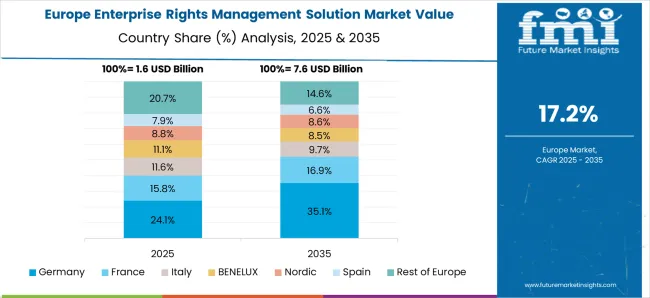
The European market is predicted to increase at a constant level of 25.6% over the projected period. European countries are more industrialized in terms of technology and equipment, which provides significant income prospects for companies delivering cutting-edge enterprise rights management solutions.
Additionally, the growing need for information security controls in the IT and telecommunications industries, as well as major companies, is likely to fuel enterprise rights management solution market revenue growth in this area.
How is the Start-up Ecosystem in the Enterprise Rights Management Solution Market?
Pickrr was co-founded in August 2020 by Rhitiman Majumder, Gaurav Mangla, Ankit Kaushik, and Ronak Agrawal. Pickrr is a global logistics company with operations throughout India. In addition to Marquee Angels, Global Business Veterans, Omidyar Networks, Ananta Capital, Guild Capital, and IIFL (India Infoline Group), the company has received funding from global investors.
Zama Organics was founded in 2020 by Shriya Naheta Wadhwa, Founder. Zama Organics is a direct-to-consumer (D2C) organic food company that works directly with farmers and artisans in India to supply organically and sustainably grown groceries, fresh fruits, and vegetables.
WeTransfer, a global network for exchanging digital files, and the blockchain platform Minima announced a groundbreaking agreement to provide information rights management solutions in February 2025. The two organisations collaborated to launch non-fungible tokens (NFTs) on the Minima network, allowing businesses throughout the world to manage their intellectual property digitally.
Fujitsu launched a new platform, Fujitsu Web3 Acceleration Platform, in February 2025 to support Web3 developers in the IT sector globally, enabling new ways to interact, create, and share data freely and securely, including digital content rights management, contracts, business transactions, and processes.
To stay ahead of their competitors, enterprise rights management system suppliers are concentrating heavily on forming alliances and releasing innovative solutions.
On 28 January 2024, Milpitas, California Seclore, a supplier of the first open, data-centric security platform in the market, announced that it is fully compatible with Microsoft Teams. Best-in-class Encryption and Rights Management can be added by organizations with a remote workforce that use Microsoft Teams as a centralized workspace for collaboration in order to automatically protect sensitive data shared and accessed from Microsoft Teams.
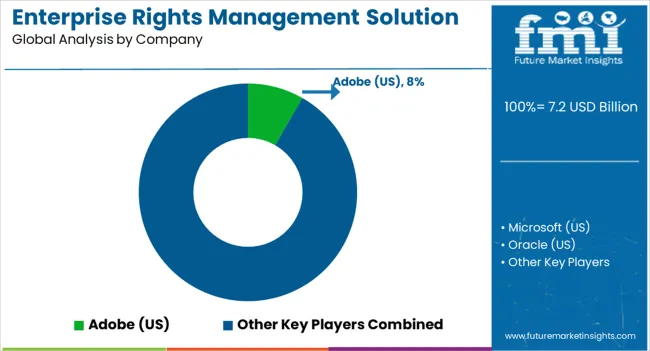
| Attribute | Details |
|---|---|
| Growth Rate | CAGR of 19.9% from 2025 to 2035 |
| Market Value in 2025 | USD 7.2 billion |
| Market Value in 2035 | USD 40.9 billion |
| Base Year for Estimation | 2025 |
| Historical Data | 2020 to 2025 |
| Forecast Period | 2025 to 2035 |
| Quantitative Units | Revenue in USD million and CAGR from 2025 to 2035 |
| Report Coverage | Revenue Forecast, Company Ranking, Competitive Landscape, Growth Factors, Trends and Pricing Analysis |
| Segments Covered | Component, Deployment, Organization size, Verticals, Region |
| Regions Covered | North America; Latin America; Europe; Asia Pacific; Middle East and Africa |
| Key Countries Profiled | United States, Canada, Brazil, Mexico, Germany, United Kingdom, France, Spain, Italy, China, Japan, South Korea, Malaysia, Singapore, Australia, New Zealand, GCC, South Africa, Israel |
| Key Companies Profiled |
Pickrr; Zama Organics |
The global enterprise rights management solution market is estimated to be valued at USD 7.2 billion in 2025.
The market size for the enterprise rights management solution market is projected to reach USD 41.3 billion by 2035.
The enterprise rights management solution market is expected to grow at a 19.0% CAGR between 2025 and 2035.
The key product types in enterprise rights management solution market are integrated with data loss prevention (dlp), integrated with enterprise file sharing and synchronization (efss), integrated with other systems, consulting services, implementation and integration services and training and support services.
In terms of organization size, large enterprises segment to command 61.4% share in the enterprise rights management solution market in 2025.






Full Research Suite comprises of:
Market outlook & trends analysis
Interviews & case studies
Strategic recommendations
Vendor profiles & capabilities analysis
5-year forecasts
8 regions and 60+ country-level data splits
Market segment data splits
12 months of continuous data updates
DELIVERED AS:
PDF EXCEL ONLINE
Enterprise A2P SMS Market Size and Share Forecast Outlook 2025 to 2035
Enterprise-Class Hybrid Storage Market Size and Share Forecast Outlook 2025 to 2035
Enterprise Social Graph Market Size and Share Forecast Outlook 2025 to 2035
Enterprise File Sync And Share Platform Market Size and Share Forecast Outlook 2025 to 2035
Enterprise Mobility Market Size and Share Forecast Outlook 2025 to 2035
Enterprise LLM Market Size and Share Forecast Outlook 2025 to 2035
Enterprise VSAT Systems Market Size and Share Forecast Outlook 2025 to 2035
Enterprise AI Governance and Compliance Market Analysis - Size, Share, and Forecast Outlook 2025 to 2035
Enterprise Resource Planning (ERP) Software Market Size and Share Forecast Outlook 2025 to 2035
Enterprise IoT Market Size and Share Forecast Outlook 2025 to 2035
Enterprise WLAN Market Size and Share Forecast Outlook 2025 to 2035
Enterprise Network Equipment Market Size and Share Forecast Outlook 2025 to 2035
Enterprise Social Networks Market Size and Share Forecast Outlook 2025 to 2035
Enterprise Video Market Analysis - Size, Share, and Forecast 2025 to 2035
Enterprise-Grade DLT Market Size and Share Forecast Outlook 2025 to 2035
Enterprise Information Archiving (EIA) Market Size and Share Forecast Outlook 2025 to 2035
Enterprise Manufacturing Intelligence Market Analysis by Deployment Type, Offering, End-use Industry, and Region Through 2035
Enterprise Laboratory Informatics Market Analysis by Type of Solution, Component, Delivery, Industry, and Region Through 2035
Enterprise File Sharing And Synchronization Market
Enterprise Flash Storage Market

Thank you!
You will receive an email from our Business Development Manager. Please be sure to check your SPAM/JUNK folder too.
Chat With
MaRIA